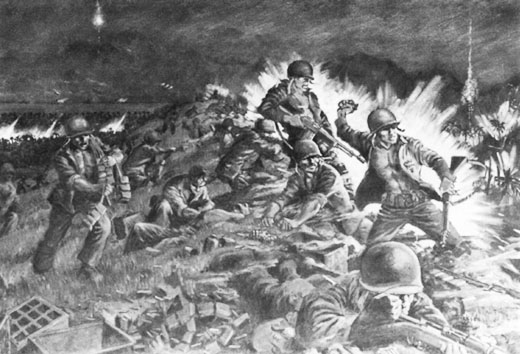
[The article below is reprinted from April 1997 edition of The International TNDM Newsletter.]
The First Test of the TNDM Battalion-Level Validations: Predicting the Winners
by Christopher A. Lawrence
CASE STUDIES: WHERE AND WHY THE MODEL FAILED CORRECT PREDICTIONS
World War ll (8 cases):
Overall, we got a much better prediction rate with WWII combat. We had eight cases where there was a problem. They are:
Makin Raid—On the first run, the model predicted a defender win. Historically, the attackers (US Marines) won with a 2.5 km advance. When the Marine CEV was put in (a hefty 2.4), this produced a reasonable prediction, although the advance rate was too slow. This appears to be a case where the side that would be expected to have the higher CEV needed that CEV input into the combat run in order to replicate historical results.
Edson’s Ridge (Night)—On the first run, the model predicted a defender win. Historically, the battle must be considered at best a draw, or more probably a defender win, as the mission accomplishment score of the attacker is 3 while the defender is 5.5. The attacker did advance 2 kilometers, but suffered heavy casualties. The second run was done with a US CEV of 1.5. This maintained a defender win and even balanced more in favor of the Marines. This is clearly a problem in defining who is the winner.
Lausdell X-Road: (Night)—On the first run, the model predicted an attacker victory with an advance rate of 0.4 kilometer. Historically, the German attackers advanced 0.75 kilometer, but had a mission accomplishment score of 4 versus the defender’s mission accomplishment score of 6. A second run was done with a US CEV of 1.1, but this did not significantly change the result. This is clearly a problem in defining who is the winner.
VER-9CX—On the first run, the attacker is reported as the winner. Historically this is the case, with the attacker advancing 1.2 kilometers although suffering higher losses than the defender. On the second run, however, the model predicted that the engagement was a draw. The model assigned the defenders (German) a CEV of 1.3 relative to the attackers in attempt to better reflect the casualty exchange. The model is clearly having a problem with this engagement due to the low defender casualties.
VER-2ASX—On the first run, the defender was reported as the winner. Historically, the attacker won. On the second run, the battle was recorded as a draw with the attacker (British) CEV being 1.3. This high CEV for the British is not entirely explainable, although they did fire a massive suppressive bombardment. In this case the model appears to be assigning a CEV bonus to the wrong side in an attempt to adjust a problem run. The model is still clearly having a problem with this engagement due to the low defender casualties.
VER-XHLX—On the first run, the model predicted that the defender won. Historically, the attacker won. On the second run, the battle was recorded as an attacker win with the attacker (British) CEV being 1.3. This high CEV is not entirely explainable. There is no clear explanation for these results.
VER-RDMX—On the first run, the model predicted that the attacker won. Historically, this is correct. On the second run, the battle recorded that the defender won. This indicates an attempt by the model to get the casualties correct. The model is clearly having a problem with this engagement due to the low defender casualties.
VER-CHX—On the first run, the model predicted that the defender won. Historically, the attacker won. On the second run, the battle was recorded as an attacker win with the attacker (Canadian) CEV being 1.3. Again, this high CEV is not entirely explainable. The model appears to be assigning a CEV bonus to the wrong side in an attempt to adjust a problem run. The model is still clearly having a problem with this engagement due to the low defender casualties.
Next: Post-WWII Cases
